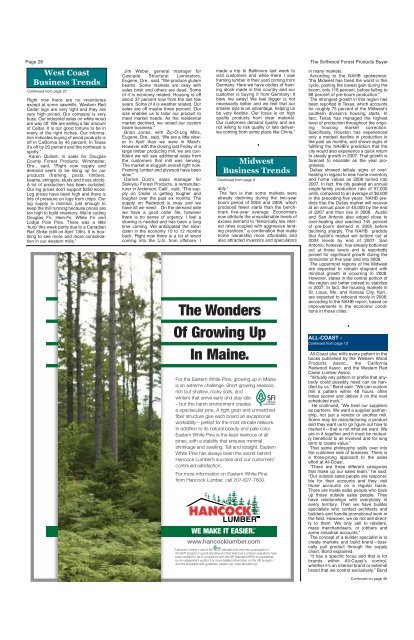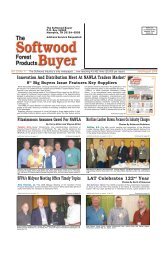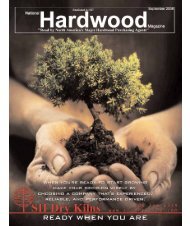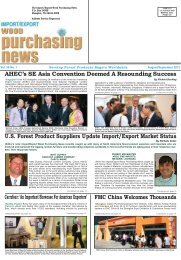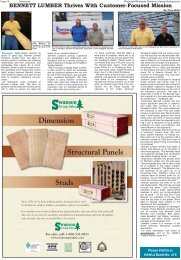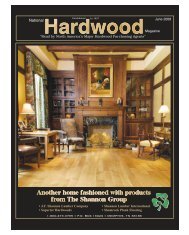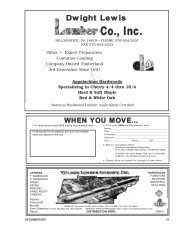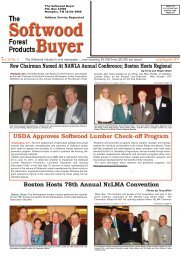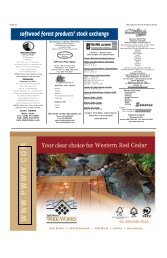CLA Convention Attracts Registrants NAWLA Regionals Attract ...
CLA Convention Attracts Registrants NAWLA Regionals Attract ...
CLA Convention Attracts Registrants NAWLA Regionals Attract ...
Create successful ePaper yourself
Turn your PDF publications into a flip-book with our unique Google optimized e-Paper software.
Page 28<br />
West Coast<br />
Business Trends<br />
Continued from page 27<br />
Right now there are no inventories<br />
except at some sawmills. Western Red<br />
Cedar logs are very tight and they are<br />
very high priced. Our company is very<br />
busy. Our industrial sales on white wood<br />
are way off. We are selling a fair amount<br />
of Cedar. It is our good fortune to be in<br />
many of the right niches. Our information<br />
indicates buying of wood products is<br />
off in California by 45 percent. In Texas<br />
it’s off by 20 percent and the northeast is<br />
spotty.”<br />
Karen Quibell, in sales for Douglas<br />
County Forest Products, Winchester,<br />
Ore., said, “Right now supply and<br />
demand seem to be lining up for our<br />
products (framing, posts, timbers,<br />
beams, stringers, studs and truss stock).<br />
A lot of production has been curtailed.<br />
Our log prices don’t support $250 wood.<br />
Log prices have been high and there is<br />
lots of pressure on logs from chips. Our<br />
log supply is minimal, just enough to<br />
keep the mill running because prices are<br />
too high to build inventory. We’re cutting<br />
Douglas Fir, Hem-Fir, White Fir and<br />
Lodge Pole Pine. There was a little<br />
‘burp’ this week partly due to a Canadian<br />
Rail Strike (still on April 13th). It is troubling<br />
to see more and more consolidation<br />
in our western mills.”<br />
Jim Weber, general manager for<br />
Cascade Structural Laminators,<br />
Eugene, Ore., said, “We produce glulam<br />
beams. Some markets are okay with<br />
sales brisk and others are dead. Some<br />
of it is economy related. Housing is off<br />
about 37 percent now from the last few<br />
years. Some of it is weather related. Our<br />
sales are off maybe three percent. Our<br />
size enables us to tailor our product to<br />
meet market needs. As the residential<br />
market declined, we raised our custom<br />
beam business.”<br />
Brian Jones, with Zip-O-Log Mills,<br />
Eugene, Ore., said, “We are a little slower<br />
in April than we were in March.<br />
However with the closing last Friday of a<br />
large timber producing mill, we are confident<br />
we will see additional sales from<br />
the customers that mill was serving.<br />
The market is sluggish overall right now.<br />
Framing lumber and plywood have been<br />
slow.”<br />
Darren Duchi, sales manager for<br />
Siskiyou Forest Products, a remanufacturer<br />
in Anderson, Calif., said, “The supply<br />
on Cedar is getting tougher and<br />
tougher over the past six months. The<br />
supply on Redwood is okay and we<br />
have all we need. On the demand side<br />
we have a good order file, however<br />
there is no sense of urgency. I feel a<br />
slowing is needed and has been a long<br />
time coming. We anticipated the slowdown<br />
in the economy 10 to 12 months<br />
back. Right now there is a lot of wood<br />
coming into the U.S. from offshore. I<br />
made a trip to Baltimore last week to<br />
visit customers and while there I saw<br />
framing lumber in their yard coming from<br />
Germany. Here we have oodles of framing<br />
stock made in this country and our<br />
customer is buying it from Germany; It<br />
blew me away! We feel bigger is not<br />
necessarily better and we feel that our<br />
smaller size is an advantage, helping us<br />
be very flexible. Our focus is on high<br />
quality products from clear material.<br />
Our customers demand quality and are<br />
not willing to risk quality or late deliveries<br />
coming from some place like China.”<br />
•<br />
Midwest<br />
Business Trends<br />
Continued from page 9<br />
ably.”<br />
The fact is that some markets were<br />
already declining during the two-year<br />
boom period of 2004 and 2005, which<br />
produced fewer starts than the benchmark<br />
five-year average. Economists<br />
now attribute the unsustainable levels of<br />
excess demand to “historically low interest<br />
rates coupled with aggressive lending<br />
practices,” a combination that made<br />
home ownership more affordable and<br />
also attracted investors and speculators<br />
The Wonders<br />
Of Growing Up<br />
In Maine.<br />
For the Eastern White Pine, growing up in Maine<br />
is an extreme challenge. Short growing seasons,<br />
rich but shallow, rocky soils, and<br />
winters that arrive early and stay late<br />
– but this harsh environment creates<br />
a spectacular pine. A tight grain and unmatched<br />
fiber structure give each board an exceptional<br />
workability – perfect for the most intricate millwork.<br />
In addition to its natural beauty and pale color,<br />
Eastern White Pine is the least resinous of all<br />
pines, with a stability that ensures minimal<br />
shrinkage and swelling. Tall and straight, Eastern<br />
White Pine has always been the secret behind<br />
Hancock Lumber’s success and our customers’<br />
continued satisfaction.<br />
For more information on Eastern White Pine<br />
from Hancock Lumber, call 207-627-7600.<br />
TM<br />
WE MAKE IT EASIER.<br />
www.hancocklumber.com<br />
*Hancock Lumber’s use of the indicates that they are a participant in<br />
the SFI ® program in good standing and that Hancock Lumber’s operations have<br />
been certified to be in compliance with the SFI Standard (SFIS) and guidelines<br />
by an independent auditor. For more detailed information on the SFI program<br />
and the standards and guidelines, please visit, www.aboutsfi.org.<br />
The Softwood Forest Products Buyer<br />
in many markets.<br />
According to the NAHB spokesman,<br />
“the Midwest has fared the worst in this<br />
cycle, posting the lowest gain during the<br />
boom, only 116 percent, before falling to<br />
68 percent of pre-boom production.”<br />
The strongest growth in this region has<br />
been reported in Texas, which accounts<br />
for roughly 75 percent of the Midwest’s<br />
southern division’s housing starts. In<br />
fact, Texas has managed the highest<br />
level of production throughout the ongoing<br />
housing market correction.<br />
Specifically, Houston has experienced<br />
only a modest decline in production in<br />
the past six months, and shows signs of<br />
fulfilling the NAHB’s prediction that the<br />
city would also experience a quick return<br />
to steady growth in 2007. That growth is<br />
forecast to escalate as the year progresses.<br />
Dallas showed telltale signs of overheating<br />
in regard to new home inventory<br />
and home values as 2006 turned into<br />
2007. In fact, the city peaked an annual<br />
single-family production rate of 57,000<br />
units, compared to an average of 38,000<br />
in the preceding five years. NAHB predicts<br />
that the Dallas market will recover<br />
at an annual pace of 45,000 by the end<br />
of 2007 and then rise in 2008. Austin<br />
and San Antonio also edged close to<br />
over-heating and reached 145 percent<br />
of pre-boom demand in 2005 before<br />
declining sharply. The NAHB predicts<br />
that Austin’s market will bottom out at<br />
2004 levels by end of 2007. San<br />
Antonio, however, has already bottomed<br />
out at those levels and is reportedly<br />
poised for significant growth during the<br />
remainder of this year and into 2008.<br />
The uppermost regions of the Midwest<br />
are expected to remain stagnant with<br />
minimal growth in occurring in 2008.<br />
However, states in the central portion of<br />
the region are better poised to stabilize<br />
in 2007. In fact, the housing markets in<br />
St. Louis, Mo. and Kansas City, Kan.,<br />
are expected to rebound nicely in 2008,<br />
according to the NAHB report, based on<br />
improvements in the economic conditions<br />
in those cities.<br />
ALL-COAST -<br />
Continued from page 13<br />
•<br />
All-Coast also mills every pattern in the<br />
books published by the Western Wood<br />
Products Assoc., the California<br />
Redwood Assoc. and the Western Red<br />
Cedar Lumber Assoc.<br />
“Virtually any pattern or profile that anybody<br />
could possibly need can be handled<br />
by us,” Bond said. “We can custom<br />
mill a pattern within 48 hours, often<br />
times sooner and deliver it on the next<br />
scheduled truck.”<br />
He continued, “We treat our suppliers<br />
as partners. We want a supplier partnership,<br />
not just a vendor or another mill.<br />
Some may be manufacturing a product<br />
and they want us to go figure out how to<br />
market it—that is not what we want. We<br />
are in it together and it must be mutually<br />
beneficial to all involved and for long<br />
term to create value.”<br />
That same philosophy spills over into<br />
the customer side of business. There is<br />
a three-prong approach to the sales<br />
effort at All-Coast.<br />
“There are three different categories<br />
that make up our sales team,” he said.<br />
“Our outside sales people are responsible<br />
for their accounts and they visit<br />
those accounts on a regular basis.<br />
There are inside sales people who back<br />
up those outside sales people. They<br />
have relationships with everybody in<br />
every territory. Then we have builder<br />
specialists who contact architects and<br />
builders and handle promotional work in<br />
the field. However, we do not sell directly<br />
to them. We only sell to retailers,<br />
mass merchandisers, or jobbers and<br />
some industrial accounts.”<br />
The concept of a builder specialist is to<br />
create markets and build brand—basically<br />
pull product through the supply<br />
chain, Bond explained.<br />
“It has a specific focus and that is for<br />
brands within All-Coast’s control,<br />
whether it’s an internal brand or external<br />
brand that we control exclusively,” Bond<br />
Continued on page 46


